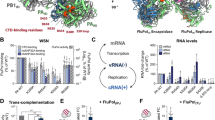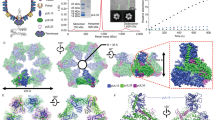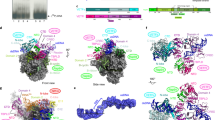Abstract
Initiation of Adenovirus DNA replicationin vitro requires the presence of three viral proteins (pTP, pol, DBP) and two cellular transcription factors, NFI and Oct-1, that stimulate replication more than 100-fold. NFI assists in binding and positioning of the DNA polymerase in the origin whereas Oct-1 changes the structure of origin DNA. Optimal templates contain, in addition to origin sequences, the covalently bound viral terminal protein (TP). This terminal protein stimulates the template activity over 20 fold compared to protein-free templates. To study the way in which TP exerts its functionin vitro we devised a novel method to isolate and label a short origin containing fragment in which the TP was bound in a functional form. This fragment replicated very efficiently and could be used for studying the binding of other replication proteins. Employing α-chymotrypsin digestion we show that for enhancement of replicationin vitro only a small part of TP is required.
Similar content being viewed by others
References
Bodnar JW, Hanson PI, Polvino-Bodnar IGM, Zempsky W, Ward DC (1989) The terminal regions of adenovirus and minute virus of mouse DNAs are preferentially associated with the nuclear matrix in infected cells. J Virol 63:4344–4353
Challberg MD, Kelly TJ (1979) Adenovirus DNA replication in vitro. Proc Natl Acad Sci USA 76:655–659
Challberg MD, Kelly TJ (1981) Processing of the adenovirus terminal protein. J Virol 38:272–277
Challberg MD, Kelly TJ (1989) Animal virus DNA replication. Annu Rev Biochem 58:671–717
Cleat PH, Hay RT (1989) Co-operative interactions between NFI and the adeno virus DNA binding protein at the adenovirus origin of replication. EMBO J 8:1841–1848
Fredman JN, Pettit SC, Horwitz MS, Engler JA (1991) Linker insertion mutations in the adenovirus preterminal protein that affect DNA replication activity in vivo and in vitro. J Virol 65:4591–4597
Freimuth PI, Ginsberg HS (1986) Codon insertion mutants of the adenovirus terminal protein. Proc Natl Acad Sci USA 83:7816–7820
Gounari F, De Francesco R, Schmidt J, Van der Vliet PC, Cortese R, Stunnenberg HG (1990) Amino terminal domain of NFI binds to DNA as a dimer and activates adenovirus DNA replication. EMBO J 9:559–566
Guggenheimer RA, Nagata K, Lindenbaum J, Hurwitz J (1987) Protein-primed replication of plasmids containing the terminus of the adenovirus genome, characterization of an in vitro DNA replication system dependent on adenoviral DNA sequences. J Biol Chem 259:7807–7814
Hay RT (1985) The origin of adenovirus DNA replication: minimal DNA sequence requirement in vivo. EMBO J 4:421–426
Mermod N, O'Neill EA, Kelly TJ, Tjian R (1989) The proline-rich transcriptional activator of CTF/NFI is distinct from the replication and DNA binding domain. Cell 58:741–753
Mul YM, Van der Vliet PC (1992) Nuclear factor I enhances Adenovirus DNA replication increasing the stability of a preinitiation complex. EMBO J 11:751–760
Pettit SC, Horwitz MS, Engler JA (1989) Mutations of the precursor to the terminal protein of adenovirus serotypes 2 and 5. J Virol 63:5244–5250
Roovers DJ, Overman PF, Chen XQ, Sussenbach JS (1991) Linker mutation scanning of the genes encoding the adenovirus type 5 terminal protein precursor and DNA polymerase. Virology 180:273–284
Salas M (1991) Protein-priming of DNA replication. Annu Rev Biochem 60:39–71
Schaack J, Yew-Wai Ho J, Freimuth P, Shenk T (1990) Adenovirus terminal protein mediates both nuclear matrix association and efficient transcription of adenovirus DNA. Gene 4:1197–1208
Sharp PA, Moore C, Haverty JL (1976) The infectivity of adenovirus 5 DNA-protein complex. Virology 75:442–456
Smart JE, Stillman BW (1982) Adenovirus terminal protein precursor. J Biol Chem 257:13499–13506
Stillman B (1989) Initiation of eukaryotic DNA replication in vitro. Annu Rev Cell Biol 5:197–245
Stillman BW, Lewis JB, Chow LT, Mathews MB, Smart JE (1981) Identification of the gene and mRNA for the adenovirus terminal protein precursor. Cell 23:479–508
Stuiver MH, Van der Vliet PC (1990) The adenovirus DNA binding protein forms a multimeric protein complex with double-stranded DNA and enhances binding of nuclear factor I. J Virol 64:379–386
Tamanoi F, Stillman BM (1982) Function of the adenovirus terminal protein in DNA replication. Proc Natl Acad Sci USA 79:2221–2225
Tamanoi F, Stillman BW (1983) Initiation of adenovirus DNA replication in vitro requires a specific DNA sequence. Proc Natl Acad Sci USA 80:6446–6450
Van Bergen BGM, Van der Ley PA, Van Driel W, Van Mansfeld ADM, Van der Vliet PC (1983) Replication of origin containing fragments that do not carry the terminal protein. Nucleic Acids Res 11:1975–1989
Van der Vliet PC (1991) The role of cellular transcription factors in the enhancement of Adenovirus DNA replication. Seminars in Virology 2:271–280
Verrijzer CP, Kal AJ, Van der Vliet PC (1990) The DNA binding domain (POU domain) of transcription factor oct-1 suffices for stimulation of DNA replication. EMBO J 9:1883–1888
Verrijzer CP, Van Oosterhout JAWM, Van Weperen W, Van der Vliet PC (1991) POU proteins bend DNA via the POU-specific domain. EMBO J 10:3007–3014
Zaballos A, Salas M (1989) Functional domains in the bacteriophage ø29 terminal protein for interaction with the ø29 DNA polymerase and with DNA. Nucleic Acids Res 17:10354–10366
Author information
Authors and Affiliations
Additional information
Abbreviations: Adenovirus, DNA replication, terminal protein, transcription factors.
Rights and permissions
About this article
Cite this article
Pronk, R., Stuiver, M.H. & van der Vliet, P.C. Adenovirus DNA replication: The function of the covalently bound terminal protein. Chromosoma 102 (Suppl 1), S39–S45 (1992). https://doi.org/10.1007/BF02451784
Received:
Issue Date:
DOI: https://doi.org/10.1007/BF02451784




